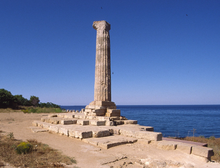Capo Colonna
Coordinates: 39 ° 1 ′ 31.6 ″ N , 17 ° 12 ′ 7.9 ″ E
Capo Colonna (Colonne; Eng. Cape Colonna), cape on the east coast of Calabria in Italy , at the same time the most easterly point of Calabria, twelve kilometers southeast of Crotone . It is a rocky promontory on the coast of Bruttium, west of the entrance to the Gulf of Tarentine (now Cape Nao). The earlier Greek and Latin names were Lakinion and Lacinium, respectively .
Antiquity
Croton and Cape Lakinion. In 708 BC During the so-called Greek colonization (8th – 6th centuries BC), the colony of Croton (now Crotone) was founded under the leadership of Myskellos from Rhypai. The area of the Polis soon included the coastal strip south of Croton with the Capo Colonna or, as it was called at that time, the Akron (Cape) Lakinion (Greek name for the "torn promontory"). On the cape was the main sanctuary of the city, dedicated to the goddess Hera Lakinia, which was built at the beginning of the 4th century BC. Was the meeting place of the Italiotischen Bund of Great Greek (coastal) cities against the Italian peoples of the inland. In 378 BC The tyrant Dionysius I succeeded in conquering Croton, the sanctuary of Hera Lakinia was sacked, and Taranto became a suburb of the Italiotische Bund . At the end of the Second Punic War (218–201 BC), the Carthaginian general Hannibal (247–183 BC), who in Italy could ultimately only rely on croton, consecrated a stele in the shrine of Hera Lakinia a fact sheet. This report served the historian Polybius as a source.
The sanctuary on the outermost foothills of the Capo Colonna enjoyed great fame in ancient times, but little of the extensive holy area has been preserved: the surrounding wall, a monumental gate, the holy street, the temple can still be seen today. In the Middle Ages, the promontory was named "Capo delle Colonne" after the ruins of the temple.
middle Ages
The Battle of Cape Colonna . In the course of the 10th century the East Frankish-German kings ( Ottonen ) renewed their claim to the rule in Italy established by Charlemagne . The acquisition of imperial Italy (951) and empire (962) by King Otto I the Great (936–973) belongs here, as well as the expansion efforts of Emperor Otto II (973–983) in southern Italy. The German ruler had resided in Italy since 980, and the year 981 saw the Saracens threaten his southern Italian positions . So it was decided in the course of this year for a military intervention, which was directed against the Saracens and the Byzantine Empire . A list of armored riders of German dioceses and abbeys, dated to early autumn 981, documents the reinforcements coming to the German army. At the end of 981 the emperor marched into southern Italy. Taranto was captured (982) and the German army turned to Calabria. The Empress Theophanu († 991) stayed with her three-year-old son Otto III. in Rossano . Emperor and troops moved further south, with skirmishes with the Saracens under the Sicilian emir Abu al-Qasim . Saracen troops and the German army lined up on July 13, 982, probably at Capo Colonna for an open battle, which initially ended with a victory for the emperor. Abu al-Qasim fell. But the remaining Saracens soon regrouped and attacked the unwary Germans. Many secular and spiritual greats from Germany, including Bishop Heinrich I of Augsburg (972–982), fell. Otto II managed to escape with difficulty on a Byzantine ship. As a result of the defeat, the imperial position in southern Italy collapsed. The political effectiveness of Otto, who returned to Rome, was initially limited. The emperor prepared a new campaign, but died on December 7, 983 in Rome of malaria .
literature
- Michael Buhlmann: Bishop Heinrich von Augsburg, Abbot Liudolf von Werden and the uprising of the three Heinriche, Essen 2007
- Luca Cerchiai, Lorena Janelli, Fausto Longo: The Greeks in Southern Italy. In search of traces between Naples and Syracuse , Darmstadt 2004, pp. 104–113
- Horst Enzensberger : Capo Colonne, battle with . In: Lexicon of the Middle Ages (LexMA). Volume 2, Artemis & Winkler, Munich / Zurich 1983, ISBN 3-7608-8902-6 , Sp. 1484.
- "Directory of Panzerreiter," in: Karl Kroeschell : Deutsche Rechtsgeschichte, Vol. 1: Until 1250 (= wv studium 8), Opladen, 8th edition, 1987, p. 143 f.
Individual evidence
- ^ Johann Jakob Egli : Nomina geographica. Language and factual explanation of 42,000 geographical names of all regions of the world. Friedrich Brandstetter, 2nd edition Leipzig 1893, p. 522


